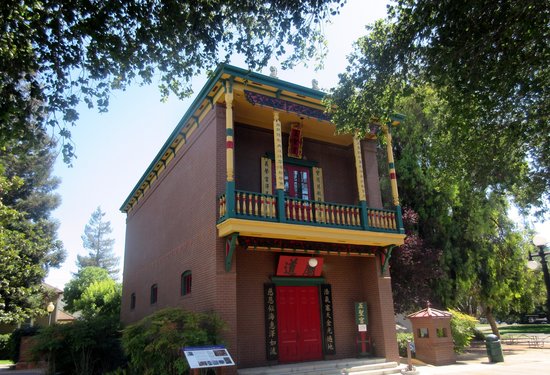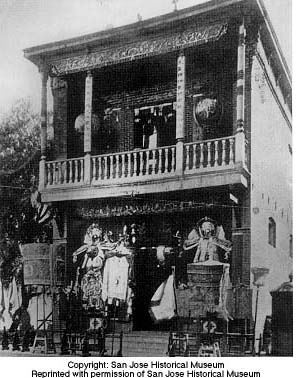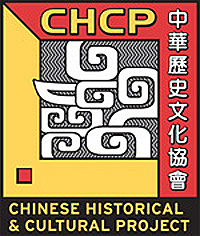|
- Home
- Museum
CHINESE AMERICAN HISTORICAL MUSEUM (CAHM)

The Chinese American Historical Museum (aka the Ng Shing Gung Museum) is located in History Park, 635 Phelan Avenue, San Jose, CA 95112, in the Ng Shing Gung building.
The museum is normally open most Saturdays (some holidays excepted) from 11:00 am to 3:30 pm. Admission for the museum is free, but special events may require an entry fee into History Park. Please check our Upcoming Events calendar for exact details of dates, times, and admission requirements prior to a visit.
Free guided tours of the museum can also be requested by contacting Anita Kwock at info@chcp.org.
PARKING:
Park at the 1650 Senter Road Parking Lot ($fee).
If this parking lot is full, street parking on Phelan Avenue is free but limited, or use the Kelley Park Disc Golf Course Parking Lot ($fee) on Phelan Avenue.
Directions to 1650 Senter Road Parking Lot ($fee): Exit Highway 280 at 10th St., then go south on 10th St., left on Keyes St., right on Senter Rd., go past the first traffic light at E. Alma Ave., then go a tenth of a mile and take the 1st left to enter the visitor parking lot. The entrance to History Park is on the far right corner of the parking lot.
Directions to Kelley Park Disc Golf Course Parking Lot ($fee): Exit Highway 280 at 10th St., then go south on 10th St., left on Keyes St., right on Senter Rd., then turn left at the second traffic light at Phelan Ave. The History Park entrance is ahead on the left; visitor parking lot is straight ahead at the end of Phelan Ave.
BUS:
VTA Bus line 73 stops at Senter Rd. and Phelan Ave., half a block from the History Park entrance.
See below for a slideshow of the museum and to take a virtual tour of the museum.
History of Ng Shing Gung (Temple of the Five Gods)
 The Ng Shing Gung, or Temple of the Five Gods, was built in San Jose’s Heinlenville Chinatown in 1888 at Taylor and Cleveland Streets. The rear of the building faced onto 6th Street. The ground floor functioned as a community center with a Chinese calligraphy and literature classroom for children. It also served as a hostel for travelers who did not belong to any of the local family associations. An elaborately carved and gilded altar stood on the second floor. The temple housed statues of five divinities: Kwan Yin, Goddess of Mercy; Choi Sun, God of Wealth; Cheng Huan, God of Canton City; Kwan Gung, God of Loyalty and Righteousness; and Tien Hou, Queen of Heaven.
The Ng Shing Gung, or Temple of the Five Gods, was built in San Jose’s Heinlenville Chinatown in 1888 at Taylor and Cleveland Streets. The rear of the building faced onto 6th Street. The ground floor functioned as a community center with a Chinese calligraphy and literature classroom for children. It also served as a hostel for travelers who did not belong to any of the local family associations. An elaborately carved and gilded altar stood on the second floor. The temple housed statues of five divinities: Kwan Yin, Goddess of Mercy; Choi Sun, God of Wealth; Cheng Huan, God of Canton City; Kwan Gung, God of Loyalty and Righteousness; and Tien Hou, Queen of Heaven.
The historic photo on this page (reprinted with permission from the San Jose Historical Museum) shows the Ng Shing Gung decorated with paper figures for San Jose Chinatown’s Da Jui celebration.
By the 1930s, many of Heinlenville’s original residents had passed on. Their children had grown up and integrated into the community at large, and the Chinese Exclusion Act had prevented new arrivals from China. When the Heinlenville estate declared bankruptcy, Heinlenville became the property of the City of San Jose, which razed the area with the exception of the Ng Shing Gung.
 Despite the objections of Clyde Arbuckle and other local historians, this last remnant of Heinlenville, was dismantled in 1949. This piece of history was recovered, when the Ng Shing Gung was replicated and dedicated to the community by the Chinese Historical and Cultural Project on September 29, 1991. CHCP also established a long-term maintenance trust fund to ensure the building will be kept up in future years.
Despite the objections of Clyde Arbuckle and other local historians, this last remnant of Heinlenville, was dismantled in 1949. This piece of history was recovered, when the Ng Shing Gung was replicated and dedicated to the community by the Chinese Historical and Cultural Project on September 29, 1991. CHCP also established a long-term maintenance trust fund to ensure the building will be kept up in future years.
The Ng Shing Gung is now part of History Park, located in Kelley Park, San Jose. Today it serves as the Chinese American Historical Museum with exhibits depicting the history and culture of Chinese and Chinese Americans in the Santa Clara Valley. Highlights of the museum include the original 1888 gilded altar, statues of the five gods, and Home Base: A Chinatown Called Heinlenville, a video by Oscar-winning documentary filmmaker Jessica Yu, which depicts the life and contributions of the Chinese Americans in the last Chinatown in San Jose.
CHCP recruits and trains volunteers to be museum docents. Visit our Volunteer page for information on this and other volunteer positions.
Below is a slideshow of photos of the Chinese American Historical Museum:

